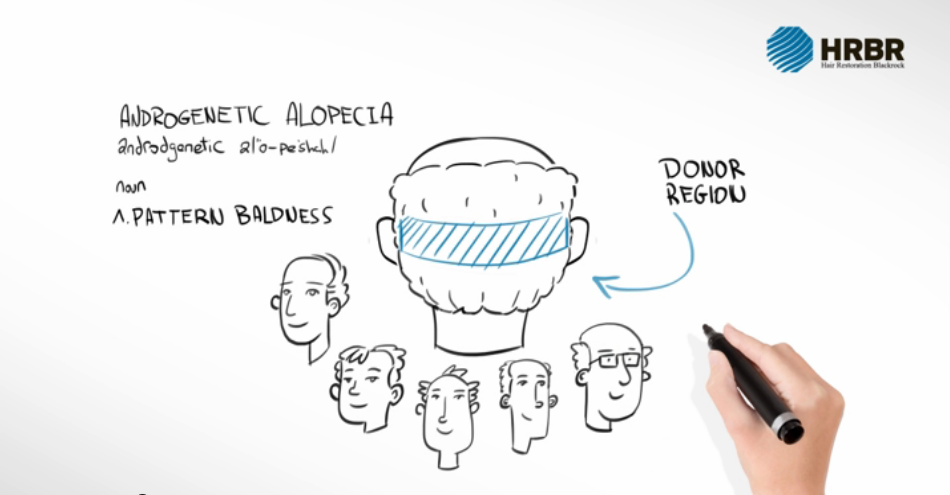Patients considering hair transplant surgery will often come across the terms FUE or FUT during the course of their research and wonder how to decide whether an FUE or FUT hair transplant is the right choice for them. At HRBR our surgical team perform both FUT and FUE hair transplants so our answer to that question is always the same – an expert hair transplant surgeon will be able to advise you on the best hair transplant procedure, be that FUE or FUT, following a detailed consultation. That being said, it’s important to understand the difference between FUE and FUT hair transplants.
FUE FUT – What’s the Difference
FUT or FUE. When carrying out a hair transplant the surgeon must ensure that the donor hair is only taken from the safe donor region. There are two surgical techniques by which hair can be removed from the donor area of a patient’s scalp. Follicular unit transplantation, FUT, and follicular unit extraction, FUE. In an FUT hair transplant a thin strip of hair is removed from the donor region. In an FUE transplant each hair graft is removed from the donor region one by one, using a punch tool. Regardless of whether FUE or FUT is used to remove the hair, the method for transplanting each of the grafts is exactly the same.
Many clinics promote FUE over FUT. This is mainly due to the fact that a smaller team is needed to carry out FUE hair transplants. When carrying out an FUT procedure, a skilled consultant surgeon is required to complete the surgery to an acceptable standard, without putting the patient at risk.
FUE or FUT Hair Transplant Video
FUE Vs FUT – Advantages and disadvantages.
For patients undergoing an FUE hair transplant, in most cases the entire scalp must be shaved in advance of the procedure. For patients undergoing an FUT procedure, only the strip of hair to be removed is trimmed, allowing patients to return to their normal lives much more quickly, without others being aware they have had a hair transplant.
As the FUE technique only allows a technician to take every second hair graft from the safe donor area, the yield of grafts is lower. As a result, many clinics are forced to remove hair from outside of this zone, which means as the patient ages, these transplanted hairs may thin and be lost.

Removing hair from outside of the donor area using FUE can also result in the circular scars outside of the donor region becoming visible as time passes. The survival rate of grafts in an FUE hair transplant procedure is lower as the accuracy of the punch tool is lower than that of a technician using a microscope.
An FUT hair transplant procedure requires a stitch to be used and the patient must return seven to ten days later to have this removed. In an FUE hair transplant procedure no stitches are needed.
FUT or FUE Hair Transplants – Scarring
Even the most skilled hair transplant surgeons cannot perform hair surgery without leaving scars, any claims to the contrary are entirely unscrupulous. Both FUE and FUT hair transplants form scars. FUT forms one linear scar, whereas FUE forms multiple circular scars, spread across a large area. For patients that like to wear their hair very short, FUE hair transplants may be the preferable option, as the scars resulting from the FUE procedure may be less noticeable in very short hair as they are more spread out.
FUE or FUT – Additional hair transplant procedures
At a later stage, should a patient decide to have a second or third hair transplant, with the FUT technique a skilled surgeon can go back and remove the linear scar from the first procedure, leaving the patient with still only one scar.
This is not possible in an FUE hair transplant, where the surgeon will always create new additional scars.
Deciding on an FUT or FUE hair transplant
At HRBR we offer both FUT and FUE hair transplants and we always believe that a hair transplant surgeon should assess the patient’s individual needs and advise on the best technique for each individual case.
Under normal circumstances at HRBR we will favour the FUT technique for larger hair transplants as the results are generally superior. For smaller hair transplants and the transplantation of scars and eyebrows often the FUE technique is the preferable option.
If you would like to arrange a consultation at HRBR, Hair Restoration Blackrock, please contact us.
About the Authour

DR Maurice Collins
Consultant Surgeon
MB, B.Ch, BAO, DLO, FRCSI, FRCS, FRCSEd.
Registered with the Medical Council of Ireland
Dr Collins is Medical Director and Team Principal of Hair Restoration Blackrock. He was educated at Belvedere College Dublin and did his undergraduate medical studies at University College Dublin. After graduating as a doctor he trained in General Surgery and received his Fellowship (FRCSI) in this specialty from the Royal College of Surgeons in Ireland.
Find out more about DR Maurice Collins and our team of doctors and surgeons.



